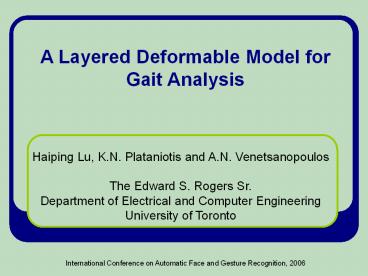A Layered Deformable Model for Gait Analysis - PowerPoint PPT Presentation
Title:
A Layered Deformable Model for Gait Analysis
Description:
Title: PowerPoint Presentation Author: Communications Group Last modified by: Haiping Lu Created Date: 10/14/2002 7:02:25 PM Document presentation format – PowerPoint PPT presentation
Number of Views:118
Avg rating:3.0/5.0
Title: A Layered Deformable Model for Gait Analysis
1
A Layered Deformable Model for Gait Analysis
Haiping Lu, K.N. Plataniotis and A.N.
Venetsanopoulos The Edward S. Rogers
Sr. Department of Electrical and Computer
Engineering University of Toronto
2
Outline
- Motivation
- Overview
- The layered deformable model (LDM)
- LDM body pose recovery
- Experimental results
- Conclusions
3
Motivation
- Automated Human identification at a distance
- Visual surveillance and monitoring applications
- Banks, parking lots, airports, etc.
- USF HumanID Gait Challenge problem
- Articulated human body model for gait recognition
- Manually labeled silhouettes
- Layered, deformable
4
Overview
Manual labeling
LDM recovery
Automatic extraction
LDM recovery
5
The Layered Deformable Model (LDM)
- Trade-off
- Complexity Vs. descriptiveness
- Match manual labeling
- Close to humans subjective perception
- Assumptions
- Fronto-parallel, from right to left.
6
LDM 22 Parameters
- Ten segments
- Static
- Lengths (6)
- Widths (3)
- Dynamic
- Positions (4)
- Angles (9)
7
LDM Layers and deformation
- Four
- layers
- Deformation
8
LDM Summary
- Summary Realistic with moderate complexity
- Compact 13 dynamic parameters
- Layered model self-occlusion
- Deformable realistic limbs
- Resemblance to manual labeling
9
Manual silhouettes pose estimation(ground truth
statistics)
- Limb joint angles
- Reliable edge orientation
- SpatialOrientation mean-shift (mode-seeking)
dominant modes ? limb orientation - Others
- Joint positions, limb widths and lengths
- Simple geometry
- Torso bounding box
- Head head top and front face
10
Post-processing
- Human body constraints
- Parameter variation limits
- Limb angles inter-dependency
- Temporal smoothing
- Moving average filtering
11
Automatic pose estimation
- Silhouette extraction (ICME06, Lu, et al.)
- Static parameters
- Coarse estimations statistics from Gallery set
- Silhouette information extraction based on ideal
human proportion - Height, head and waist center, joint
spatial-orientation domain modes of limbs
12
Ideal proportion of the human eight-head-high
figure in drawing
13
Automatic pose estimation
- Dynamic parameters
- Geometry on static parameters and silhouette
information, constraints. - Limb switching detection
- Thighs lower legs variations of angles.
- Arms opposite of thighs
- Frames between successive switch
- Post-processing smoothing
14
Experimental results
- 285 sequences from five data sets, one gait cycle
each sequence. - Imperfection due to silhouette extraction noise
and estimation algorithm - Feedback LDM recovery to silhouette extraction
process may help.
15
LDM recovery results
- Raw
- LDM
- manual
- LDM
- auto
16
LDM recovery example (revisit)
Manual labeling
LDM recovery
Silhouette extraction
LDM recovery
17
Angle estimation left right thighs
From manual silhouettes
From automatically extracted silhouettes
18
Error rate (in percentage) for lower limb angles
19
Conclusions
- A layered deformable model for gait analysis
- 13 Dynamic and 9 static parameters
- Body pose recovery from manual (ground truth) and
automatically extracted silhouettes. - Average error rate for lower limb angles 7
- Overall close match to manual labeling, accurate
efficient model for gait analysis - Future work model-based gait recognition
20
Acknowledgement
- Thanks Prof. Sarkar from the University of South
Florida (USF) for providing the manual
silhouettes and Gait Challenge data sets.































